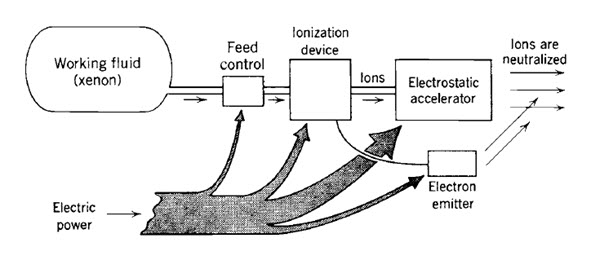# ELECTRIC ROCKET PROPULSION:
Table of Contents:
- What Is Electric Rocket Propulsion?
- Types Of Electric Rocket Propulsion
- Advantages Of Electric Rocket Propulsion
- Disadvantages Of Electric Rocket Propulsion
What Is Electric Rocket Propulsion?
The electric rocket propulsion system is a propulsion system which uses electrical, and possibly also magnetic fields, to change the velocity of a spacecraft. Most of these kinds of spacecraft propulsion systems work by electrically expelling propellant (reaction mass) at high speed. Electric thrusters typically use much less propellant than chemical rockets because they have a higher exhaust speed (operate at a higher specific impulse) than chemical rockets. Due to limited electric power, the thrust is much weaker compared to chemical rockets, but electric propulsion can provide thrust for a longer time.
In all electric propulsion, the source of the electric power (nuclear, solar radiation receivers, or batteries) is physically separate from the mechanism that produces the thrust. This type of propulsion has been handicapped by heavy and inefficient power sources. The thrust usually is low, typically 0.005 to 1 N. In order to allow a significant increase in the vehicle velocity, it is necessary to apply the low thrust and thus a small acceleration for a long time (weeks or months).
Simplified Schematic Diagram Of Arc-Heating Electric Rocket Propulsion System
Types of Electric Rocket Propulsion:
There are basically three main types of electric rocket propulsion system and as follows,
- Electrothermal rocket propulsion
- Electrostatic rocket propulsion
- Electromagnetic rocket propulsion
Of the three basic types, electrothermal rocket propulsion most resembles the chemical rocket units; propellant is heated electrically (by heated resistors or electric arcs) and the hot gas is then thermodynamically expanded and accelerated to supersonic velocity through an exhaust nozzle. These electrothermal units typically have thrust ranges of 0.01 to 0.5 N, with exhaust velocities of 1000 to 5000 m/sec, and ammonium, hydrogen, nitrogen, or hydrazine decomposition product gases have been used as propellants.
The two other types – the electrostatic or ion propulsion engine and the electromagnetic or magnetoplasma engine – accomplish propulsion by different principles and the thermodynamic expansion of gas in a nozzle, as such, does not apply. Both will work only in a vacuum. In an ion rocket, a working fluid (typically, xenon) is ionized (by stripping off electrons) and then the electrically charged heavy ions are accelerated to very high velocities (2000 to 60,000 m/sec) by means of electrostatic fields. The ions are subsequently electrically neutralized; they are combined with electrons to prevent the buildup of a space charge on the vehicle.
In the magnetoplasma rocket, an electrical plasma (an energized hot gas containing ions, electrons, and neutral particles) is accelerated by the interaction between electric currents and magnetic fields and ejected at high velocity (1000 to 50,000 m/sec).
- Electrothermal – Propellant is heated electrically and expanded thermodynamically; i.e., the gas is accelerated to supersonic speeds through a nozzle, as in the chemical rocket.
- Electrostatic – Acceleration is achieved by the interaction of electrostatic fields on non-neutral or charged propellant particles such as atomic ions, droplets, or colloids.
- Electromagnetic – Acceleration is achieved by the interaction of electric and magnetic fields within a plasma. Moderately dense plasmas are high temperature or nonequilibrium gases, electrically neutral and reasonably good conductors of electricity.

Simplified Schematic Diagram Of A Typical Ion Rocket
Advantages of Electric Rocket Propulsion:
- Electric rocket propulsion engines are more efficient than chemical ones, in the sense that they require much less propellant to produce the same overall effect.
- It offers very flexible layout and hence will have 30% reduction in volume compared to mechanical drive system.
- It offers load diversity due to single central power generation.
- It offers greater benefits to the environment due to reduction in fuel consumption by 14000 tons per year.
- It generates less noise as electric motor has low vibration characteristics.
- The system is designed to be highly automated and self monitoring.
- It has very low emissions.
- It offers flexibility in the space.
- Electric thrusters also give the ability to regulate the force applied to the spacecraft very accurately, making it possible to control the spacecraft’s position and orientation along its orbit with incomparable precision.
- It offers safety.
- It offers redundancy.
Disadvantages of Electric Rocket Propulsion:
- It is an expensive system.
- It has lesser efficiency compared to other systems.
- It is a complex system due to more equipment.
To find more topics on our website…
Do you want to refer wikipedia? Please click here…

